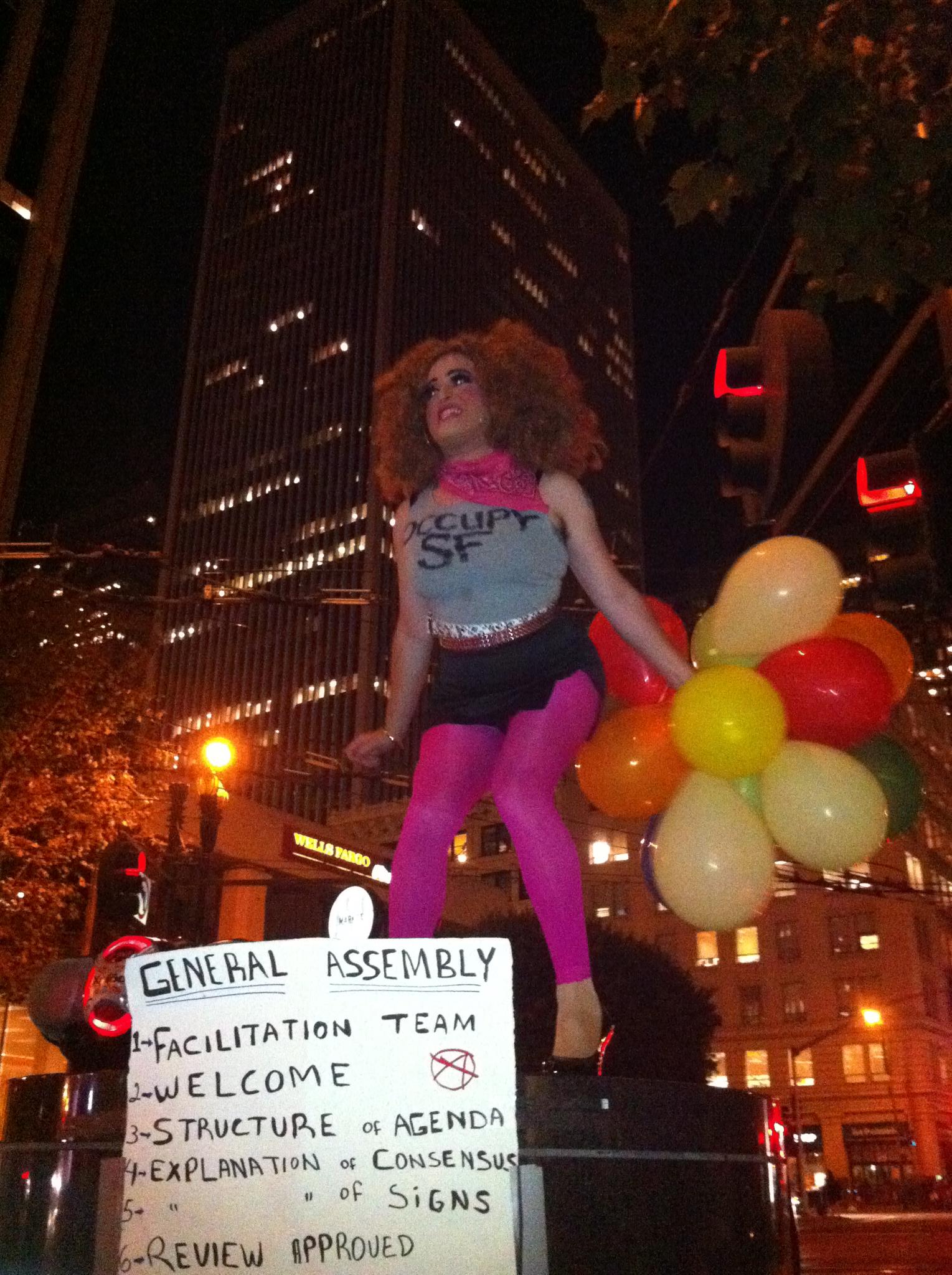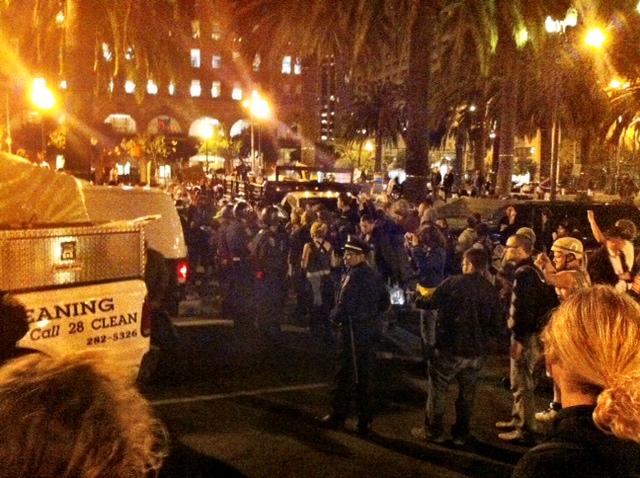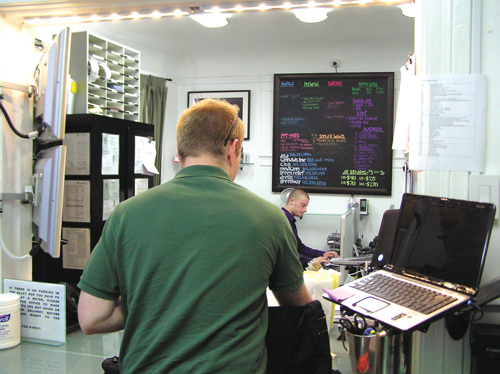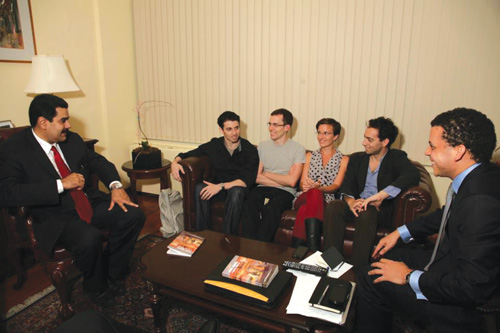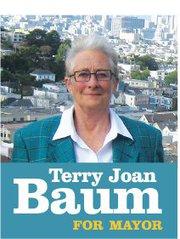Music listings are compiled by Emily Savage. Since club life is unpredictable, it’s a good idea to call ahead or check the venue’s website to confirm bookings and hours. Prices are listed when provided to us. Submit items for the listings at listings@sfbg.com. For further information on how to submit items for the listings, see Picks.
WEDNESDAY 19
ROCK/BLUES/HIP-HOP
Anika, Jel, Starving Weirdos Independent. 8pm, $15.
Arcadio, Turtle Rising El Rio. 9pm, $6.
Rome Balestrieri vs. JC Rockit Johnny Foley’s, 243 O’Farrell, SF; www.duelingpianosatfoleys.com. 9:30pm.
Lindsey Buckingham Regency Ballroom. 8pm, $39-$59.
“Dark Knights: A Very Spooky Birthday” Verdi Club, 2424 Mariposa, SF; www.verdiclub.net. 8pm, $3-$5. With Tartufi, Michael Musika, Aan, and Night Genes.
El Elle, Boyz IV Men, Puce Moment Cafe Du Nord. 8pm, $10.
K.D. Lang, Siss Boom Bang Fillmore. 8pm, $59.
Laughing Prophets of Doom, Family Stoned, Bad Daddies Hemlock Tavern. 9pm, $5.
Modern Day Moons 50 Mason Social House, SF; www.50masonsocialhouse.com. 10pm, free.
Nick Waterhouse and the Tarots, Allah-Las Slim’s. 8:30pm, $19.
Violet Hour, Myonics, Symbolick Jews Bottom of the Hill. 9pm, $8.
JAZZ/NEW MUSIC
Chris Amberger Trio Yoshi’s. 6 and 9:30pm.
Cosmo AlleyCats Le Colonial, 20 Cosmo Place, SF; www.lecolonialsf.com; 7-10pm.
Dink Dink Dink, Gaucho, Michael Abraham Amnesia. 7pm, free.
Greg Gotelli Quartet Medjool, 2522 Mission, SF; www.medjoolsf.com. 6-9pm, free.
Jazz organ party Royal Cuckoo, 3202 Mission, SF; www.royalcuckoo.com. 7:30pm, free.
Ricardo Scales Top of the Mark, 999 California, SF; www.topofthemark.com. 6:30pm, $5.
FOLK/WORLD/COUNTRY
La Ruya Elbo Room. 9pm, $10. With dance by Melissa Cruz and Fanny Ara, plus special guest Radio Istanbul.
DANCE CLUBS
Booty Call Q-Bar, 456 Castro, SF; www.bootycallwednesdays.com. 9pm. Juanita Moore hosts this dance party, featuring DJ Robot Hustle.
Mary Go Round Lookout, 3600 16th St, SF; www.lookoutsf.com. 10pm, $5. Drag with Suppositori Spelling, Mercedez Munro, and Ginger Snap.
Megatallica Fiddler’s Green, 1333 Columbus, SF; www.megatallica.com. 7pm, free. Heavy metal hangout.
No Room For Squares Som., 2925 16th St, SF; (415) 558-8521. 6-10pm, free. DJ Afrodite Shake spins jazz for happy hour.
Third Wednesdays Underground SF. 10pm-2am, $3. With Ms. Jackson, DJ Loryn, and Becky Knox spinning electro, tech, house, and breaks.
Vespa Beat Bliss Bar, 4026 24th St, SF; www.blissbarsf.com. 9pm, free. MSK.fm spins raregrooves, electroswing, and boogie.
THURSDAY 20
ROCK/BLUES/HIP-HOP
Bleak Ethnique, S.F. Blows Knockout. 9:30pm, $5.
“Communion” Swedish American Hall. 7:30pm, $15. With Matthew and the Atlas, David Mayfield Parade, and Lauren Shera.
John Doe, Dead Rock West Great American Music Hall. 8pm, $20.
Victoria George, Or, The Whale Independent. 8pm, $15.
Hank IV, Dead Farmers, Outdoorsmen, Switftumz, Lenz Thee Parkside. 9pm, $10. Plus more.
Mason Jennings Fillmore. 8pm, $35.
Mercury Falls Brick & Mortar Music Hall. 8pm, $13.
Miyavi Slim’s. 8pm, $30.
MJ’s Brass Boppers, El Cajon Hemlock Tavern. 9pm, $6.
Theophilus London Rickshaw Stop. 9pm, $13.
Parties, Bye Bye Blackbirds, Trevor Childs and the Beholders Amnesia. 9pm, $7.
Rags Tuttle vs Rome Balestrieri Johnny Foley’s, 243 O’Farrell, SF; www.duelingpianosatfoleys.com. 9:30pm.
San Cha Black Glitter 50 Mason Social House, SF; www.50masonsocialhouse.com. 10pm, free.
Snake Rattle Rattle Snake, Kill Moi, Symbolick Jews Milk. 9pm, $5.
Struts, Hi-Nobles, Lydia & the Projects El Rio. 9pm, $7.
Total B.S., Lecherous Gaze Cafe Du Nord. 9pm, free. Black Heart Tattoo 7th Anniversary and SFO Tattoo Convention Pre-Party.
David Vandervelde, Fling, Lee Malone Bottom of the Hill. 9pm, $12.
JAZZ/NEW MUSIC
Blues Organ Party Royal Cuckoo, 3202 Mission, SF; www.royalcuckoo.com. 7:30pm, free.
Jamie Dubberly & Orquesta Dharma Rassela’s Jazz Club, 1534 Fillmore, SF; (415) 346-8696. 8pm, $12.
Kai Eckhardt Group Savanna Jazz, 2937 Mission, SF; www.savannajazz.com. 7:30pm, $10.
NaJe Yoshi’s, 6pm.
Ricardo Scales Yoshi’s. 8pm, $25.
Stompy Jones Top of the Mark, 999 California, SF; www.topofthemark.com. 7:30pm, $10.
Tom Lander & Friends Medjool, 2522 Mission, SF; www.medjoolsf.com. 6-9pm, free.
FOLK/WORLD/COUNTRY
DaMaDa Revolution Cafe, 3248 22nd St, SF. (415) 642-0474. 9pm, free.
Twang! Honky Tonk Fiddler’s Green, 1330 Columbus, SF; www.twanghonkytonk.com. 5pm. Live country music, dancing, and giveaways.
DANCE CLUBS
Afrolicious Elbo Room. 9:30pm, $5. DJs Pleasuremaker and Señor Oz spin Afrobeat, Tropicália, electro, samba, and funk.
Arcade Lookout. 9pm, free. Indie dance party.
Double Down John Collins, 138 Minna, SF; www.johncollins.com. 9pm, $5-$7. Live performance by 40 Love, with DJs E Da Boss, Kung Fu Chris, B Maj, and Whooligan.
Guilty Pleasures Gestalt, 3159 16th St, SF; (415) 560-0137. 9:30pm, free. DJ TophZilla, Rob Metal, DJ Stef, and Disco-D spin punk, metal, electro-funk, and 80s.
Thursday Special Tralala Revolution Café, 3248 22nd St, SF; (415) 642-0474. 5pm, free. Downtempo, hip-hop, and freestyle beats by Dr. Musco and Unbroken Circle MCs.
Thursdays at the Cat Club Cat Club. 9pm, $6 (free before 9:30pm). Two dance floors bumpin’ with the best of 80s mainstream and underground with Dangerous Dan, Skip, Low Life, and guests.
Tropicana Madrone Art Bar. 9pm, free. Salsa, cumbia, reggaeton, and more with DJs Don Bustamante, Apocolypto, Sr. Saen, Santero, and Mr. E.
FRIDAY 21
ROCK/BLUES/HIP-HOP
Airborne Toxic Event Fillmore. 9pm, $31.
Bang Data, Candelaria, V for Volume, Tender Box, DJ Kool Kyle, Roger Mas Elbo Room. 9pm, $8-$10.
Battlehooch, Chuck Prophet, This Old Earthquake Rickshaw Stop. 8:30pm, $10-$12. Save KUSF benefit.
Rome Balestrieri, Jason Marion, JC Rockit Johnny Foley’s, 243 O’Farrell, SF; www.duelingpianosatfoleys.com. 9pm.
Beehavers, Magic Leaves, Arborea Amnesia. 9pm, $7.
Jesse Brewster, Luvplanet, Kyle Alden and the Bee-Loud Glade Band Cafe Du Nord. 9:30pm, $10-$12.
Bryan Minus & the Disconnect, Antenna, EndRoit, Blah Boutique Kimo’s. 9pm.
“Check Yo Ponytail” Mezzanine. 9pm, $20. With Spank Rock, Death Set, Big Freedia, Pictureplane, and DJ Franki Chan.
Cool Water Canyon, Skyline Taxi Slim’s. 9pm, $13-$15.
Fab Faux Yoshi’s. 8 and 10pm, $46.
Karl Denson’s Tiny Universe, Anders Osborne Independent. 9pm, $25.
McCabe & Mrs. Miller Make-Out Room. 7:30pm. Performing Bruce Springsteen’s Nebraska.
Fixx Showroom, 1000 Van Ness, SF; www.theshowroomsf.com. 7:30 and 9pm, $25.
Rip Offs, Nobunny, Statics, Personal and the Pizzas, Shrouds Bottom of the Hill. 8:30pm, $20.
Tom Morello and the Nighwatchmen Great American Music Hall. 9pm, $23.
JAZZ/NEW MUSIC
Black Cat Orchestra Top of the Mark, 999 California, SF; www.topofthemark.com. 9pm, $10.
Gina Harris and Torbie Phillips Savanna Jazz, 2937 Mission, SF; www.savannajazz.com. 7:30pm, $10.
Justin & Mattias Yoshi’s. 6pm.
Tony Ybarra and Ken Ryals Red Poppy Art House. 8pm, $15.
FOLK/WORLD/COUNTRY
Mucho Axe 50 Mason Social House, SF; www.50masonsocialhouse.com. 10pm, free.
Zahara! Swedish American Hall. 8pm, $25. With Kina Mendez, Moroccan Musicians of El Hamideen, and more.
Vaughan Johnson Jazz Combo Jack’s Club, 2545 24, SF; (415) 641-1880. 7pm, free.
DANCE CLUBS
Afro Bao Little Baobab, 3388 19th St, SF; (415) 643-3558. 10pm, $5. Afro and world music with rotating DJs including Stepwise, Steve, Claude, Santero, and Elembe.
DJ Greg J Medjool, 2522 Mission, SF; www.medjoolsf.com. 10:30pm.
DJ What’s His Fuck Riptide Tavern, 3639 Taraval, SF; (415) 681-8433. 9pm, free. Spinning old school punk.
Dubstep Producer Battle Club Six 1, 60 Sixth St., SF; www.clubsix1.com. 10pm, $5-$10.
Damian Lazarus, Art Department, Droog Public Works. 10pm, $15-$17.
Oldies Night Knockout. 9pm, $2-$4. Doo-wap, one hit wonders, and soul with DJ Primo, Daniel, and Lost Cat.
Old School Dance Party El Rio. 9pm. DJs spinning freestyle, new wave, hip-hop, and old school jams.
Pledge: Fraternal Lookout. 9pm, $3-$13. Benefiting LGBT and nonprofit organizations. Bottomless kegger cups and paddling booth with DJ Christopher B and DJ Grind.
Vintage Orson, 508 Fourth St, SF; (415) 777-1508. 5:30-11pm, free. DJ TophOne and guest spin jazzy beats for cocktalians.
SATURDAY 22
ROCK/BLUES/HIP-HOP
“Afrofunk Festival” Brick & Mortar Music Hall. 8pm, $15. With Sila, Black Nature, DJ Jeremiah, and more.
Mickey Avalon Slim’s. 8:30pm, $26.
Blank Stares, Slouching Stars, Rabbles Hemlock Tavern. 9:30pm, $7.
Calle 13 Fillmore. 8pm, $58.
Conspiracy of Venus, Alameda, Bridgit Jacobsen Amnesia. 5pm.
Mano Cherga, Chervona, Makru Musica Amnesia. 9pm, $7.
Karl Denson’s Tiny Universe, Anders Osborne Independent. 9pm, $25.
Lyres, Roy Loney and the Phantom Movers, Subsonics, Dukes of Hamburg Bottom of the Hill. 8:30pm, $15.
Jason Marion, Rags Tuttle, Rome Balestrieri Johnny Foley’s, 243 O’Farrell, SF; www.duelingpianosatfoleys.com. 9pm.
No Statik, Future Skullz, Hunting Party El Rio. 9pm, $7.
Ocean Grove, Voxhaul Broadcast Great American Music Hall. 9pm, $13-$15.
Rantoul, Lone Surfer and his Highlander 2’s, Tee N Dee Explosion Thee Parkside. 2pm, $5. Plus more.
Ronkat Spearman’s Katdelic Boom Boom Room, 1600 Fillmore, SF; www.boomboomroomblues.com. 10pm, $10.
Ana Sia Mezzanine. 9pm, $10. With Eprom, Debut, DJG, Salva, Chrissy Murderbot, B.Bravo & the Starship, and more.
Maria Taylor, Big Harp, Dead Fingers Rickshaw Stop. 9pm, $10-$14.
This Charming Band, Jean Genies Cafe Du Nord. 9:30pm, $12.
JAZZ/NEW MUSIC
Broken Strongs Yoshi’s. 6pm.
Joshua Redman and Brad Mehidau Herbst Theatre, 401 Van Ness, SF; www.sfwmpac.org. 7 and 9pm, $30-$75.
Suzanna Smith Savanna Jazz, 2937 Mission, SF; www.savannajazz.com. 7:30pm, $10.
FOLK/WORLD/COUNTRY
Cradle Duende featuring MCRAI Red Poppy Art House. 8pm, $12-$20.
Dark HollowRiptide Tavern, 3639 Taraval, SF; (415) 681-8433. 10pm, free.
Eoin Harrington Band Yoshi’s. 10pm, $25.
Go Van Gogh Revolution Cafe, 3248 22nd St, SF. (415) 642-0474. 9pm, free.
Saturday Night Salsa Ramp, 855 Francois, SF; www.facebook.com/therampsf. 5:30pm, $10.
DANCE CLUBS
Afro Bao Little Baobab, 3388 19th St, SF; (415) 643-3558. 10pm, $5. Afro and world music with rotating DJs including Stepwise, Steve, Claude, Santero, and Elembe.
Bootie SF: DJ Tripp vs. FarOff DNA Lounge. 9pm, $8-$15. Video mashup battle, live rock band Smash-Up Derby, Peach Chante, indie-electro with Six & Candy.
Debaser: Hip-Hop Edition Knockout. 9pm, $5. G-funk, hip-hop, classic b-sides with DJ Jamie Jams, EmDee, and Stab Master Arson.
DJ Nick Medjool, 2522 Mission, SF; www.medjoolsf.com. 10:30pm.
4OneFunktion Elbo Room. 10pm, $5. Live hip-hop and DJs Quest, 2 Fresh, and Cue.
Mango El Rio. 3-8pm, $8-$10. Hip-hop, dancehall, salsa, and reggaeton with DJs Edaj, Marcella, Ola, and La Coqui.
Masquerotica Concourse Exhibition Center, 620 Seventh St, SF. 8pm, $45. With Mutaytor, DJ Dan, Afrolicious All-Stars, Unkle Paul’s Dark Kabaret, Eric McFadden Experience, and more.
SUNDAY 23
ROCK/BLUES/HIP-HOP
Anthrax, Testament, Death Angel, Chimaira, Rise to Remain Warfield. 6pm, $35.
Atriarch Knockout. 9pm, $6.
Browntown West, Okie Rosette, Ampro’s Chuck Lido Bottom of the Hill. 2-6pm. Benefit for Starr King Elementary.
Nero Order, Ninth Moon Black, Embers Hemlock Tavern. 9pm, $6.
Phantom Surfers, Legendary Stardust Cowboy, Lateenos, Harold Ray Budget Rock Review Thee Parkside. 1pm, $10. Plus more.
Saves the Day, Bayside, I Am the Avalanche Fillmore. 7pm, $26.50.
War on Drugs, Purling Hiss, Carter Tanton Independent. 8pm, $12-14.
JAZZ/NEW MUSIC
Jazz Organ Party with Lavay Smith and Chris Siebert Royal Cuckoo, 3202 Mission, SF; www.royalcuckoo.com. 7:30pm, free.
Jim Hall Quartet Herbst Theatre, 401 Van Ness, SF; www.sfwmpac.org. 7pm, $20-$45.
Little Brown Brother Blues & Jazz Jam Savanna Jazz, 2937 Mission, SF; www.savannajazz.com. 7pm, $5.
Organsm Jazz Show Braza Theater, 2781 24 St, SF. (401) 286-7871. 11am-4pm, free. With Tender Tim Shea, Jim Gunderson, and David Schaff.
Louis Prima Jr. Yoshi’s. 7pm, $25.
Tom Lander & Friends Medjool, 2522 Mission, SF; www.medjoolsf.com. 6-9pm.
FOLK/WORLD/COUNTRY
“Sunday Streets Bluegrass Jam” Amnesia. 12-4pm. With Rock Falls and more.
Sunday Night Salsa Ramp, 855 Francois, SF; www.facebook.com/therampsf. 5:30pm, $10.
DANCE CLUBS
Batcave Club 93, 93 9th St, SF 10pm, $5. Death rock, goth, and post-punk with Steeplerot, XChrisT, Necromos and c_death.
Dub Mission Elbo Room. 9pm, $6. Dub, dubstep, roots, and classic dancehall with DJ Sep, Ludichris, and Sake One.
Jock Lookout, 3600 16th St, SF; www.lookoutsf.com. 3pm, $2. Raise money for LGBT sports teams while enjoying DJs and drink specials.
La Pachanga Blue Macaw, 2565 Mission, SF; www.thebluemacawsf.com. 6pm, $10. Salsa dance party with live Afro-Cuban salsa bands.
MONDAY 24
ROCK/BLUES/HIP-HOP
Gillian Grassie. Red Poppy Art House. 7pm, $10-$15.
Andrew Ripp, Steve Moakler, Michael Annuzzi Cafe Du Nord. 8pm, $12.
JAZZ/NEW MUSIC
Bossa Nova Tunnel Top, 601 Bush, SF; (415) 722-6620. 8-11:30pm, free. Live acoustic Bossa Nova.
David Hardiman’s SF All-Star Big Band Yoshi’s. 8pm, $10-$25.
Todd Murray Rrrazz Room, 222 Mason, SF; www.therrazzroom.com. 8pm, $30.
FOLK/WORLD/COUNTRY
Earl Brothers Amnesia. 6pm.
Brian Joseph El Rio. 8pm, $20-$200. Benefit for Community Boards.
DANCE CLUBS
Death Guild DNA Lounge. 9:30pm, $3-5. Gothic, industrial, and synthpop with Joe Radio, Decay, and Melting Girl.
M.O.M. Madrone Art Bar. 6pm, free. DJs Timoteo Gigante, Gordo Cabeza, and Chris Phlek playing all Motown every Monday.
Sausage Party Rosamunde Sausage Grill, 2832 Mission, SF; (415) 970-9015. 6:30-9:30pm, free. DJ Dandy Dixon spins vintage rock, R&B, global beats, funk, and disco at this happy hour sausage-shack gig.
Sucker Punch reunion Elbo Room. 10pm, $5. With original resident DJs Rapid Fire and more. Hosted by Nate Always.
TUESDAY 25
ROCK/BLUES/HIP-HOP
Death Valley High, Simoom, They Are All Dead, Seatraffic Kimo’s. 9pm, $6.
Devin Townsend Project, Ocean Slim’s. 8pm, $16.
Fist Fam, Rec-League, Grand Invincible, BPos Elbo Room. 9pm, $10.
Jeffrey Foucault, Kate Gaffney, Jim Hanft with Samantha Yonack Cafe Du Nord. 8pm, $12.
Gold Panda, Jonti, Blackout Make Out Independent. 8pm, $15.
Grieves and Budo, Prof, MC Type Bottom of the Hill. 9pm, $14.
Male Bonding, WATERS, Lilac Rickshaw Stop. 8pm, $12.
Garrett Pierce, Himalayan Bear Hemlock Tavern. 9pm, $7.
Tech N9ne with Jay Rock, Krizz Kaliko, Kutt Calhoun, Flawless Regency Ballroom. 8pm, $32.
JAZZ/NEW MUSIC
Hot Club of San Francisco Yoshi’s. 8pm, $14.
Todd Murray Rrrazz Room, 222 Mason, SF; www.therrazzroom.com. 8pm, $30.
Tin Cup Serenade Burritt Room at Crescent Hotel, 417 Stockton, SF; www.crescentsf.com. 6-9pm, free. DANCE CLUBS Eclectic Company Skylark, 9pm, free. DJs Tones and Jaybee spin old school hip hop, bass, dub, glitch, and electro.


